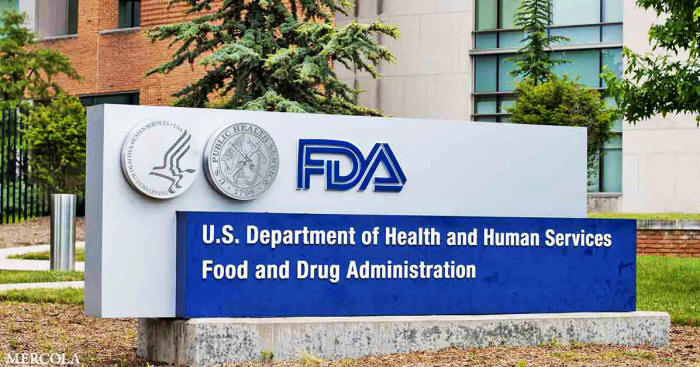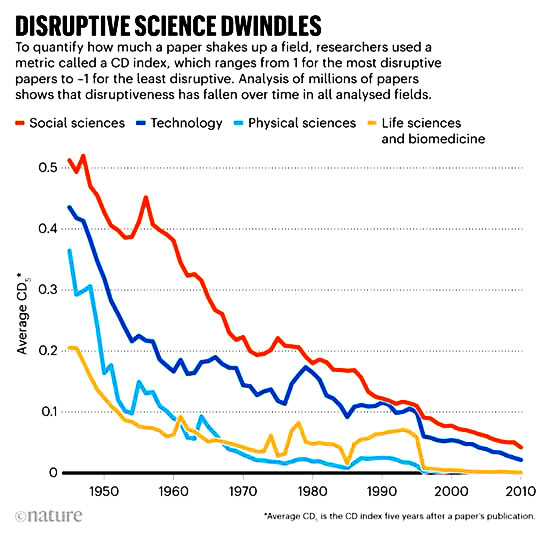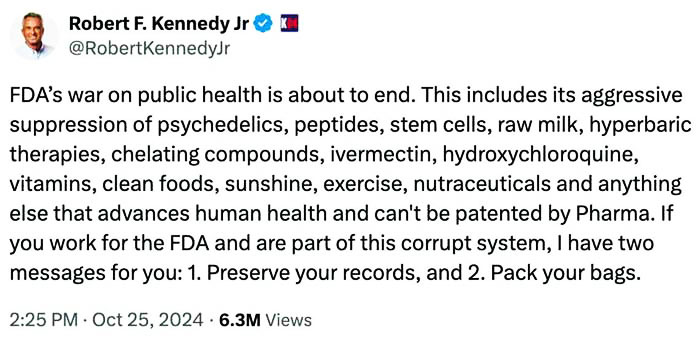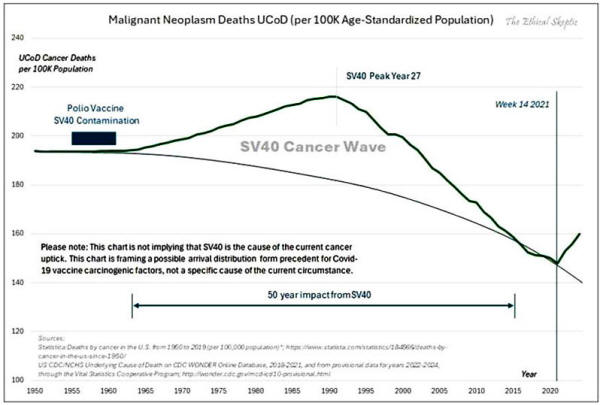|

by A Midwestern Doctor
December 20, 2024
from
Mercola Website
PDF version

Can RFK Jr.
take down an FDA gone Rogue?
Created to protect Americans,
corrupted to control them...
Discover
how food industry lobbyists
infiltrated the FDA, transforming it
into one of the most mistrusted agencies
in government.
Is RFK Jr.
ready to expose their dark secrets
and bring justice to the people?
Author's
note:
This is an abridged version of
an article about the FDA's unconscionable war against DMSO
(which set the agency's behavior for decades to come),
an article about the FDA's past vaccine disasters and
a longer article which goes into greater detail on the points
mentioned here along with other promising therapies the FDA has
blacklisted (which can be read
here).
Story at-a-glance
-
The U.S. Food and Drug Administration was originally created in 1906
to protect public safety, but food industry lobbyists gradually
gained influence and forced out its first leader Harvey Wiley, who
had fought against harmful food additives
-
Under the FDA's "Generally Recognized as Safe" (GRAS) designation,
many potentially harmful food additives have been allowed into the
food supply, with nearly 99% of new food chemicals since 2000
exploiting this loophole
-
The FDA has consistently opposed natural therapies like
DMSO (a
chemical shown to help with pain, neurological conditions, and
injuries), raw milk, and certain stem cell treatments, while pushing
potentially dangerous pharmaceutical alternatives
-
Historical FDA vaccine scandals include the 1955 polio vaccine
contaminated with SV40 virus, the 1976 swine flu vaccine that caused
Guillain-Barré syndrome, and Gulf War Syndrome linked to mandated
experimental vaccines. Recent controversial FDA approvals include
SSRI antidepressants despite known suicide risks, Alzheimer's drugs
with dangerous side effects, and Ozempic for weight loss without
sufficient long-term safety data
-
Proposed reforms include separating approval tracks for conventional
and alternative medicines, implementing stronger conflict of
interest laws, making trial data public, and creating better
mechanisms to revoke approvals of harmful drugs
For most of my life, I've observed
the FDA belligerently suppress
natural treatments and any unorthodox therapy which threatens the
medical monopoly while simultaneously railroading through a variety
of unsafe and ineffective drugs regardless of how much public
protest the agency meets.
Consider this 2004 Senate testimony by the
FDA scientist who got Vioxx banned that accurately described exactly
what would come to pass with the
COVID vaccines two decades later:
As such, I do not hold the FDA in a positive light, especially given
that during COVID-19, I (like many others) spent hundreds of hours
trying to get the agency to allow the limited use of off-patent
therapeutics for COVID-19 - all of which ultimately went nowhere due
to the unjustifiable roadblocks the agency kept putting up.
Over the past year, especially since Trump's election, I've received
many questions about FDA reform.
To address the issue properly, I've
carefully examined both sides...
In medicine, "sensitivity" refers to a test's ability to correctly
identify those who have a condition (e.g., detecting an infection),
while "specificity" measures how well the test avoids false
positives (i.e., correctly identifying those who don't have the
condition).
The challenge is that improving one often reduces the
other.
For example, increasing
the PCR cycle threshold in COVID tests made
it more likely to detect infections (higher sensitivity), but also
increased false positives (lower specificity).
This trade-off leads
to problems, like breast cancer screenings, where high sensitivity
can result in unnecessary "treatments" for women who don't actually
have cancer. 1
The FDA faces a similar challenge:
it must prevent harmful foods and
drugs from reaching the market while ensuring useful products aren't
blocked.
Though this seems straightforward, it's incredibly
difficult, and the FDA has often failed at both, even with
leadership dedicated to public health. 2
Crime Against the Food Law
In the late 1800s, food producers were selling adulterated products,
and pharmaceutical companies peddled medicines with secret
ingredients like opium and alcohol.
Public outrage grew, especially
after exposés like Upton Sinclair's The Jungle, 3 which helped spark
the 1906 Pure Food and Drug Act. 4
This law gave the Bureau of
Chemistry the power to ensure accurate labeling and prevent harmful
additives in food.
The director of the Bureau of Chemistry (and thus the first head of
the FDA), Harvey Wiley 5 conducted tests on food additives, proving
they made healthy volunteers sick.
While the public and many
scientists supported his findings, the food industry fought back
with powerful lobbyists and legal tactics.
Note: The additives Wiley scrutinized were,
-
boric acid and borax
-
salicylic acid (aspirin) and salicylates
-
benzoic acid and
benzoates
-
sulfur dioxide and sulfites
-
formaldehyde
-
sulfate of
copper (used to green produce)
-
saltpeter (nitrates)
Gradually, the food industry hijacked the presidency, and in 1912,
Wiley resigned, realizing he could achieve more for America's health
as a private citizen than within the government.
Wiley's book "The History of a Crime Against the Food Law"
6 details
much of the same abhorrent industry tactics we see happening now.
For example,
a series of investigative reports 7 have recently shown
that the processed food industry's lobbyists are now working
fervently behind the scenes to block RFK's nomination and ability to
Make America Healthy Again.
Those tactics also highlight a key point Wiley made - the only way
to create change in this industry is to coax the public at large to
demand it, as the moment you rely upon the members of the government
to fix it, lobbyists will crush those efforts.
Generally Recognized as "Safe"
Many food additives are "generally recognized as safe" (GRAS),
meaning they're widely used without regulation.
Wiley faced two
major issues:
The industry often faked products to cut costs, like selling grain
alcohol as whiskey or using polluted waters to enlarge oysters.
Despite evidence of harm,
the food industry claimed these additives
were essential for production, even though competitors showed
higher-quality products could be made without them.
Wiley also
warned that chronic exposure to additives could cause long-term
health issues, such as organ damage and aging.
Sadly, his concerns were ignored as industry influence grew and he
was unable to ban them.
As a result, these "safe" additives have
contributed to widespread chronic illness in society.
Note: Those additives included sodium benzoate,
8 sulfur dioxide,
alum (potassium aluminum sulfate), sulfur dioxide, saccharin,
modified corn sugars, saccharin, and nitrogen bleached flour - many
of which were linked to cancer. 9
Sadly, since 2000, nearly 99% of
new food chemicals added to the food supply chain have exploited the
GRAS loophole. 10
I believe the widespread use of aluminum in processed foods is
particularly detrimental (due to
it greatly impairing the
physiologic zeta potential and causing micro-clotting throughout the
body), and provides a key explanation for why you often see certain
rapid improvements in individuals once they stop eating processed
foods.
The Kefauver-Harris Amendment
In the years that followed Wiley's departure, the handicapping of
the FDA continued.
As such, the FDA agent assigned to the morning
sickness drug thalidomide could only stall but not reject it - a
tactic that prevented catastrophic birth defects across America.
A
1962 amendment was then passed, giving the FDA the power to block
unsafe drugs.
This law 11 gave the FDA excessive power, slowing drug approval and
causing mismanagement.
It also required "well-controlled" trials for
drug approval, which the FDA defined as expensive double-blind
randomized controlled trials (RCTs).
This:
-
Elevated RCTs, making drug approval a
"pay-to-play" system, with approval costs soaring to 0.98 to
4.54 billion. 12,13
-
Created bias, as RCTs cost so much they inevitably produce results
in favor of their sponsor (which often outweigh any benefit of their
expensive "controlled" design).
-
Ignored smaller, effective observational
trials, which could yield the same results without the high
costs (proven by a 2014 Cochrane Review). 14
-
Stifled innovative therapies, as unorthodox treatments lacking
costly RCTs were dismissed. As a result, medical innovation in the
U.S. slowed, with scientists financially pressured to avoid
challenging existing paradigms, leading to fewer groundbreaking
discoveries despite advancing technology.

Because the FDA had rapidly expanded in numerous directions it was
not prepared for, it subsequently frequently failed to fulfill its
primary responsibilities (e.g., taking something harmful off the
market), and it simultaneously took things away Americans actually
wanted.
This in turn led to numerous committees investigating the FDA (e.g.,
Commissioner Ley's Kinslow report of his agency's serious
shortcomings) 15 and key officials with integrity like Ley being
kicked out, 16 all of which were encapsulated a series of
scathing articles that were published by the New York Times
in 1977. 17
In my eyes, the most important thing about this period of FDA
reforms was that the FDA was the most complained about agency in the
government.
Congress made numerous attempts to fix it (as did
ethical FDA officials) - but nothing was ever solved.
The DMSO Saga
Over the last three months, I've begun exploring a remarkable
forgotten side of medicine:
DMSO...!
This simple and freely available
natural chemical is incredibly effective at treating a variety of
(often "incurable") conditions, including many that are otherwise
impossible to treat including:
-
Strokes, paralysis, a wide range of neurological disorders (e.g.,
Down Syndrome and dementia) and many circulatory disorders including
Raynaud's, varicose veins, hemorrhoids (discussed
here).
-
Chronic pain (e.g., from a bad disc, bursitis, arthritis or complex
regional pain syndrome) and a wide range of tissue injuries
including sprains, concussions, burns, surgical incisions, spinal
cord injuries (discussed
here).
-
A wide range of autoimmune, protein and contractile disorders such
as scleroderma, amyloidosis, and interstitial cystitis (discussed
here).
-
A variety of head conditions, such as tinnitus, vision loss, dental
problems, and sinusitis (discussed
here).
-
A wide range of internal organ diseases such as pancreatitis,
infertility, and liver cirrhosis (discussed
here).
-
A wide range of skin conditions including acne, herpes, hair loss,
varicose veins (discussed
here).
Likewise, since publicizing this research, I've received
over a
thousand reports from readers who then took it and had almost
unbelievable results that precisely match what many reported in the
1960s and 1970s.
This all raises a simple question.
How is it that no one knows about DMSO or that an agent that could dramatically reduce the need for
opioids 18 or prevent millions with stroke and spinal cord injury
from having a life of disability 19 never saw the light of day?
As DMSO rapidly spread across America in the 1960s, the FDA reversed
its initial positive stance, declaring DMSO dangerous without
evidence.
This move aimed to avoid processing a flood of new drug
applications, protect the status quo and then justify the FDA's
newfound police powers.
Despite extensive safety studies showing DMSO posed no risk to
humans, 20 for decades, the FDA continued to demonize it, claiming a
lack of evidence for efficacy 21 (as DMSO's characteristic effects
make blinded trials with it impossible).
Because of this, DMSO only became available decades later after the
public got fed up with the FDA targeting natural medicines and the
1994 Dietary Supplement Health and Education Act 22 was enacted
(which removed the FDA's ability to regulate natural medicines).
The FDA's War Against Natural Medicine
Shortly before the election, RFK Jr. gave what I considered to be
one of the most important statements in the entire campaign:

This tweet 23 touched upon the fact that for decades the American
Medical Association has done everything it can to remove
life-changing natural therapies from the market that compete with
the medical monopoly (e.g.,
ultraviolet blood irradiation and
alternative cancer cures) and the FDA has followed in their
footsteps.
For example:
| GHB
- In the
1990s,
a life-changing natural sleep aid spread
across America that safely cured insomnia - so
the FDA banned it. In contrast, sleeping pills
block restorative sleep (which is critical for
health) and make you 2 to 5X more likely to die. |
|
Psychedelic therapy -
MDMA-assisted psychotherapy is the only existing
effective treatment for veterans with PTSD, but
the FDA has blocked its approval despite
compelling ("uncontrolled") clinical trials. 24
Veterans hence often seek treatment abroad due
to FDA restrictions. |
| Chelation
therapy -
EDTA chelation therapy (especially a low doses 25)
is effective for cardiovascular health, but the
FDA has consistently targeted it despite the NIH
reluctantly proving it worked. 26 |
|
Umbilical cord blood stem cells - FDA regulations under
Biden made it difficult to offer this
life-changing therapy and shut down the
companies who provided it. |
|
Sunlight and health -
The
dermatology industry has deceptively demonized
sunlight as a cause of deadly skin cancers,
overlooking its importance for overall health
and cancer prevention, with studies showing
those who avoid sunlight are 60% to 130% more
likely to die. 27 |
| Raw
milk - The
FDA has targeted raw milk sellers, despite
growing demand and evidence that pasteurization
destroys critical nutrients and creates
allergens. Note:
Pasteurizing milk also makes it go from
a zeta potential enhancing substance to one that
impairs it 28
(causing congestion throughout the body). |
|
Infant formula and seed oils - The Infant Formula Act of 1980
mandates formulas include problematic seed oils,
which may contribute to childhood obesity, as
they impair metabolism and promote rapid weight
gain. 29 |
|
Vaccine Coverups
Many have been horrified to learn that the FDA and CDC
systematically ignored every possible sign the COVID vaccines were
dangerous as they pushed it on more and more people (e.g., recently
leaked recordings show how stubbornly the head of FDA's vaccine
division refused to acknowledge any of the evidence brought forward
by a group of permanently injured vaccine recipients).
This severe betrayal of trust from our authorities thus made many
ask,
"How could this have happened...?"
In truth, this did not come out
of nowhere.
Rather it was simply the subsequent escalation of a
longstanding tendency by the government to push vaccines they knew
were unsafe and ineffective to market. 30
|
Vaccine coverups
and failures by the FDA and CDC |
|
Historical vaccine
disasters - Many vaccine-related issues
have been ignored or covered up by health
authorities, including many deadly "hot
lot" incidents. |
|
Polio vaccine issues - In the
1950s, defective rushed polio vaccine contained
live polio viruses and caused cases of
paralysis. Further, it was later discovered that
the vaccine contained SV40, 31
a cancer-causing virus, which was also not
disclosed to the public. Around 40 to 98 million
Americans were exposed to SV40, leading to a
massive wave of cancer cases. 32
Note: To produce the emergency
COVID vaccines at scale, a novel manufacturing
process was used, which caused them to be
contaminated with dangerous DNA-altering
bacterial plasmids 33
that contained part of the SV40 virus. |
|
Influenza vaccine
failures - In 1945, a government
scientist discovered that early flu vaccines
were ineffective and unsafe. Despite this, the
scientist faced retaliation and the vaccines
were released. This led to a 1972 Senate hearing
that removed 32 dubious vaccines from the
market. |
|
Swine flu vaccine
disaster (1976) - The
swine flu
vaccine, released despite evidence showing the
flu posed no risk, caused hundreds of cases of Guillain-Barré syndrome, paralysis, and deaths.
Like the Polio vaccines, the FDA was warned by
its own scientists these vaccines were not safe
but nonetheless pushed them to market.
However
it occurred in an era when 60 Minutes was
willing to do a segment on the disaster (which
has numerous remarkable parallels to what
happened during COVID-19).
|
|
Gulf War Syndrome -
During the Gulf War, the FDA waived the
protections soldiers had from experimental drugs
and U.S. soldiers were given many, 34
including a disastrous anthrax vaccine 35
(which due to its rushed "emergency" production
was contaminated). A wave of severe chronic
illness (Gulf War Syndrome) followed, affecting
250,000 veterans (discussed further
here). Despite this, the vaccine remained
mandated for decades until a court overturned it
in 2004. |
|
HPV vaccine controversy
- The lucrative HPV vaccine, was
approved by the FDA despite red flags throughout
the clinical trials (e.g., high rates of
autoimmunity, death, and it causing cervical
cancer - discussed further
here). Once it hit the market, a tsunami of
injuries occurred, yet the FDA and CDC continued
to relentlessly defend and promote the vaccine. |
|
|
Other disastrous
drug approvals |
|
SSRI antidepressants -
The FDA approved SSRIs like Prozac despite poor
evidence for their effectiveness 36
and known severe side effects
including suicidal tendencies,
emotional numbness, violent behavior and mass
shootings. These risks were concealed from
the public, despite extensive complaints and
lawsuits later showing those dangers were
detected in the trials. 37 |
|
Alzheimer's drugs -
A new and misguided class of Alzheimer's drugs,
38
despite failing to show efficacy and causing
dangerous side effects like brain swelling and
bleeding in 40% of participants, 39
was approved by the FDA after bypassing an
advisory committee's negative vote. The agency's
manipulation of the approval process raised red
flags, leading to widespread scrutiny. 40 |
|
Ozempic and weight loss
drugs - The FDA also approved weight
loss drugs like Ozempic without sufficient
evidence,
promoting them aggressively despite concerns
over long-term safety and effectiveness. The
drug's promotion has led to it being widely
marketed, even for use in children. |
|
In summary,
the FDA has an established history of
approving unsafe and ineffective vaccines and drugs, often
suppressing evidence and protecting
corporate interests over public
safety.
Conclusion
At this point, I've seen a variety of proposals put forward to fix
the FDA, which alternate between reforming the agency and scrapping
it entirely. In my eyes, the core dilemmas are:
-
Inadequate resources
Effectively regulating foods and drugs in
America is a gargantuan task that exceeds the scope of what the FDA
can do.
-
Corruption and conflicts of interest
The FDA often defers to
pharmaceutical companies for drug safety evaluations, leading to a
pay-to-play system where approval is influenced by financial
contributions rather than scientific integrity.
-
Lack of accountability
Once a drug is approved, the FDA rarely
revokes approval, even when evidence of harm emerges.
-
Selective prosecution
The FDA targets natural medicine because
they lack the resources to fight back like pharmaceutical companies,
creating a (risk-free) facade of protecting the public.
Proposed solutions for restructuring the FDA include:
-
Conflict of interest laws
Legislation that retroactively
nullifies votes or decisions made by regulators or panel members
with current or future financial ties to pharmaceutical companies.
41
-
Separate approval tracks
Create two approval systems: one for
conventional drugs (focusing only on safety) and another for
alternative therapies with proven safety 42 but questionable
efficacy.
-
Market-driven efficacy
Allow market demand to determine a
drug's efficacy rather than relying solely on FDA approval, as
consumers often have better insight into what works.
-
Public involvement
Involve the public and AI systems in
reviewing large (anonymized) patient datasets to help identify
(frequently overlooked) red flags.
-
Transparent data access
Make drug trial data publicly available
to expose fraudulent or incomplete data, (e.g., the COVID vaccine
trials were rife with fraud). 43
-
Revocation of drug approvals
Implement mechanisms to revoke
approval for unsafe drugs, including allowing state-level bans and
empowering courts to remove harmful drugs from the market.
Previously, implementing ideas like these was impossible, but now
that platforms like Twitter ("X") have broken the mass media's
stranglehold on democracy, I believe it can happen.
However, as
Wiley presciently warned, that,
can only happen if the public becomes
actively involved... something the MAHA movement (and each of you)
now makes possible!
A Note from Dr. Mercola About the Author
A Midwestern Doctor (AMD) is a board-certified physician from the
Midwest and a longtime reader of Mercola.com.
I appreciate AMD's
exceptional insight on a wide range of topics and am grateful to
share it. I also respect AMD's desire to remain anonymous since AMD
is still on the front lines treating patients.
To find more of AMD's
work, be sure to check out
The Forgotten Side of Medicine on Substack.
Sources and
References
1 Amazon,
Mammography Screening: Truth, Lies and Controversy
2, 21 The
Forgotten Side of Medicine, November 29, 2024
3 History,
May 10, 2023
4 Britannica,
Pure Food and Drug Act
5 Wikipedia,
Harvey Washington Wiley
6 Selene
River Press, The History of a Crime Against the Food Law,
1929
7 Real
Clear Investigations, November 20, 2024
8, 9 EWG,
February 15, 2024
10 EWG,
April 13, 2022
11 Public
Law 87-781, October 10,1962
12 JAMA.
2020 Mar 3;323(9):844-853
13 Pharmacoeconomics.
2021 Aug 9;39(11):1243-1269
14 Cochrane
Database Syst Rev. 2014 Apr 29;2014(4):MR000034
15, 16 Wikipedia,
Herbert L. Ley Jr.
17 The
New York Times, December 11, 1969
18 The
Forgotten Side of Medicine, September 29, 2024
19 The
Forgotten Side of Medicine, September 15, 2024
20 The
Forgotten Side of Medicine, October 12, 2024
22 Council
for Responsible Nutrition, Dietary Supplement Health &
Education Act (DSHEA)
23 X,
Robert Kennedy Jr, October 26, 2024
24 NPR,
June 4, 2024
25 The
Forgotten Side of Medicine, May 16, 2023
26 National
Center for Complementary and Integrative Health, August 2024
27 J
Intern Med. 2016 Oct;280(4):375-87
28 The
Forgotten Side of Medicine, March 31, 2024
29 Matern
Child Nutr. 2018 Apr 14;14(3):e12602
30, 31 The
Forgotten Side of Medicine, November 20, 2023
32 X,
Ethical Skeptic, August 16, 2024
33 The
Forgotten Side of Medicine, February 20, 2023
34 Amazon,
Vaccine A: The Covert Government Experiment That's Killing
Our Soldiers - and Why GI's Are Only the First Victims
35 Am
J Public Health. 2002 May;92(5):715-721
36, 37 The
Forgotten Side of Medicine, December 10, 2023
38 The
Forgotten Side of Medicine, November 13, 2022
39 BMJ
2021;375:n2975
40 The
New York Times, December 29, 2022 (Archived)
41 The
Forgotten Side of Medicine, November 12, 2024
42 The
Forgotten Side of Medicine, June 23, 2024
43 The
Forgotten Side of Medicine, March 14, 2023
|





